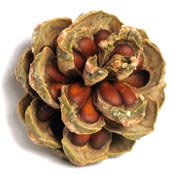Global pine nut data
Management of woodlands for pine nut production will yield 100 times more income than will management for livestock forage
The United States is losing
as the result of poor land policies. Even more importantly,
policy continues to be based on short sited, antiquated industrialization.
Why are American Public Lands not used for pine nuts?
Cattle, timber and mining industries are the primary commercial
users or "stakeholders" as they are called - of American Public Lands. As
such, we extract our resources in way they aren't renewable. We are losing
our ability to sustain ourselves in this country. As biodiversity becomes
threaten by "industrialized" use of land - the balance scale shifts.
Biodivesity offers economic diversity, as well as for the fundamental support
for life systems.

HOW DO ALL THOSE CATTLE CHANGE THE LAND?
In Nevada, for example, it takes
from 10 to 100 acres of P-J to produce 1 animal unit month (AUM) of grazing, depending on age and condition of the stand. The value of an AUM in 1985 was $1.37. Thus the grazing income rate is $1.37 to
13.7 cents per acre per year. Recent nut harvests have been averaging about 70 - 250
pounds per acre and in
one area, where a large chaining has reverted back to pinyon, about two
Christmas trees
per acre have been harvested over the past 8 years and the area still
looks undisturbed.
Using the best grazing allocations or 10 acre AUM as the benchmark
the
following revenues could be generated on an annual basis:
Grazing:
10/acres/AUM @ $1.37/AUM
= $1.37
Pinenuts:
70 - 250 lbs per acre X 10 Acres
x.$0.20
= $140 - $500
Christmas Trees:
1 tree/acre X 10 Acres X $2.50 = $25.00
Discounting the nut harvest by three to account for the cyclical nature of pinyon nut crops reduces the revenues potential for this product to $47.00 - $167/AUM. Thus on a 10 acre AUM, revenues for non grazing sources would far exceed those that could be generated from grazing alone. The greatest revenue potential however lies in some sort of multi-use management strategy. P-J A Commercial Resource?, Dwane D. Van Hooser and Osborne E. Casey, Pinyon-Juniper Conference, Reno, Nevada, January 13-16, 1986.
In Nevada, for example, it takes from 10 to 100 acres of P-J to produce 1 animal unit month (AUM) of grazing, depending on age and condition of the stand.
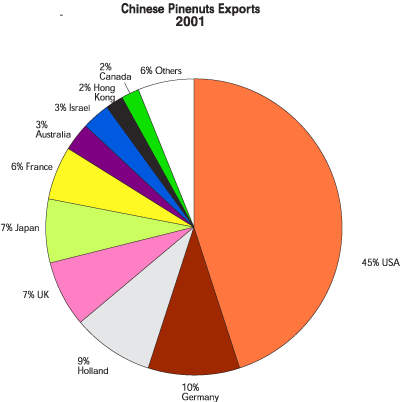
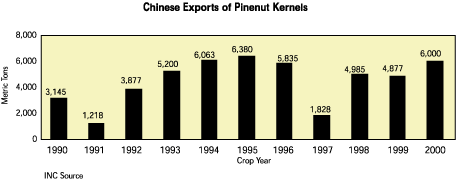 Pine nuts are a big industry around the world.
Pine nuts are a big industry around the world.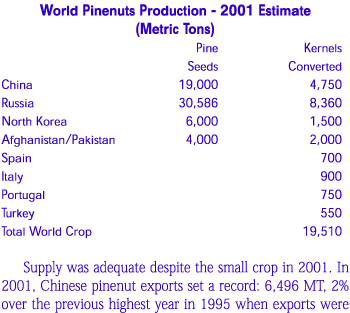
The US consumes 45% of nuts exported from China
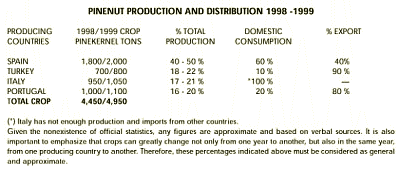
Commercial Value in US Pine Nut MARKET
In 1999, The United States Imported 3,746,800 Pounds of Pine nuts From China
|
December 2000 Units of (Quantity: Kilograms) |
December 2000 Customs Value, in Thousands of Dollars |
Year 2000 - Dec. Units of Quantity: Kilograms) |
Year 2000- December Customs Value, in Thousands of Dollars |
|
| World Total | 167,272 | 1,036 | 1,908,542 | 17,066 |
| China | 150,004 | 918 | 1,617,014 | 14,671 |
| Hong Kong | 15,000 | 95 | 140,848 | 1,144 |
| Italy | 0 | 0 | 975 | 12 |
| Pakistan | 0 | 0 | 84,774 | 510 |
| Portugal | 2,368 | 23 | 25,048 | 273 |
| Spain | 0 | 0 | 28,286 | 314 |
| Turkey | 0 | 0 | 11,597 | 144 |
Source: U.S. Trade Quick-Reference Tables: December 2000 Imports, www.ita.doc.gov
Valuing America's pine nuts
My work with the pine nuts began with a desire
to see wilderness "pay for itself", in order to protect it from destruction.
Since that time, I have learn much - The planet is a living system,
with thousands of subsystems, supporting its health.
Forests, are a major system., from microbes which
create life in the soil up to the "heavy feeders" the trees. Forests
play the role of cooling the earth, - shade, cleaning the air, and
the water. Forests and a tree plantations are different. The
soil can not be substained in a place which lacks biodiversity. I am trying
to help land managers understand the substainable nature of the whole forests,
through understanding the long term value of the non-timber forest species.
Maybe
those terrible fires and drought are the result of systems, which have broke down.
Managing Pinon-Juniper Ecosystems for Sustainablity
and Social Needs,
General
Technical Report RM 236.
In terms of economics, New Mexico State University
published an interesting study by John Fowler in 1987 on the economic value
of products of the pinyon-juniper woodlands. In summary, Fowler found that
the value of forage available in the woodlands amortized on a sustainable
yield basis comes to $2.90 per acre at today's prices. In comparison,
Fowler also calculated the value of the pinyon nuts available on the a sustained
yield basis to be $300.00 annually at today's prices (based on 250 pounds
of nuts per acre times $6.00 per pound (average price 1988-1992)= $1,500.00
per nuts per acre in a good year, divided by 5 (most areas produce a good
crop every 5 years) equals an annual value of $300.00 per acre per year. Jeff Kiln, Environmental Education Consultant, New Mexico State
Land Office, "My Vision of the Pinon/Socioeconomic Potential of Pinon Woodlands,"
Managing Pinon-Juniper Ecosystems for Sustainablity and Social Needs, General
Technical Report RM 236.



